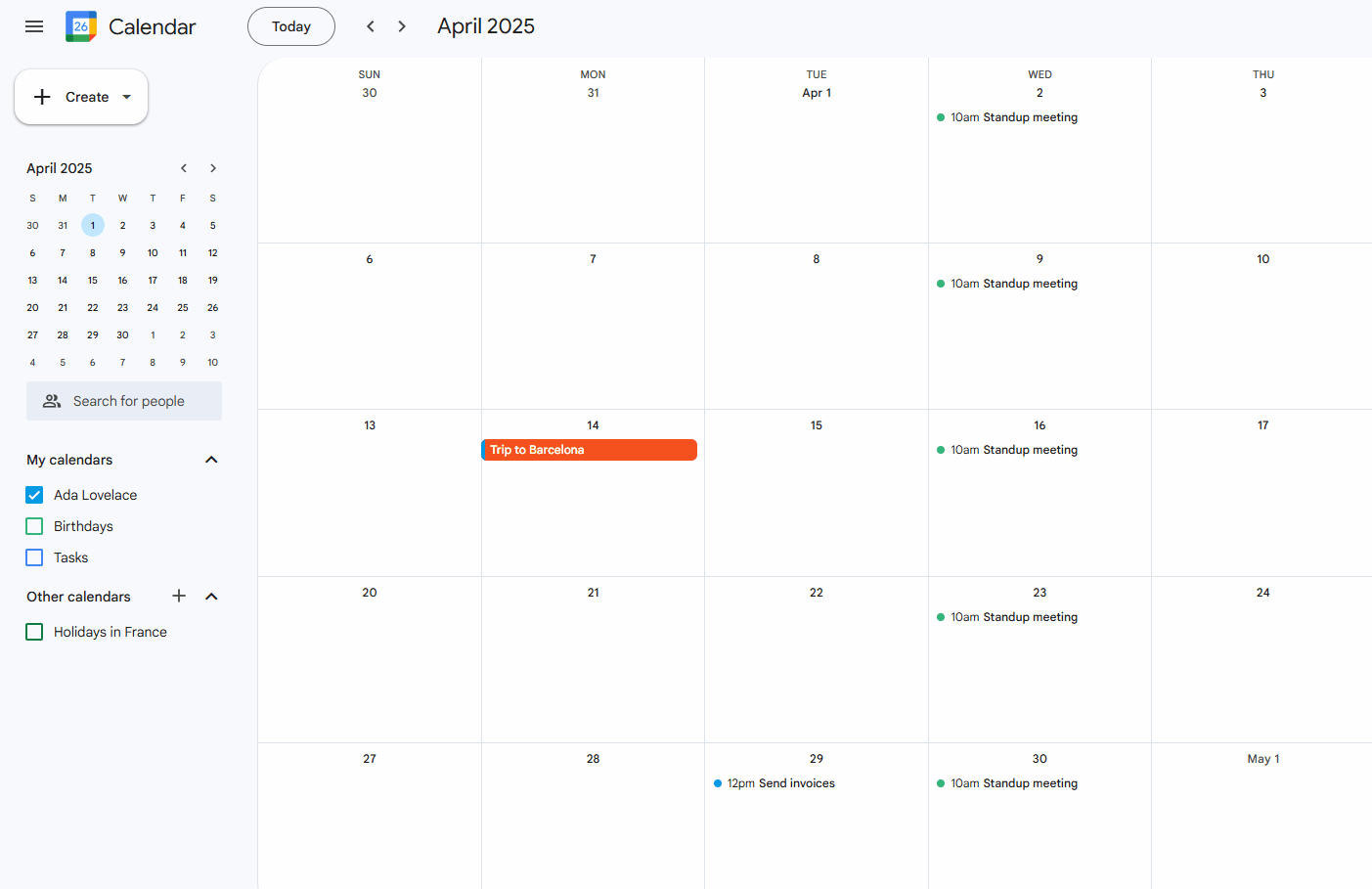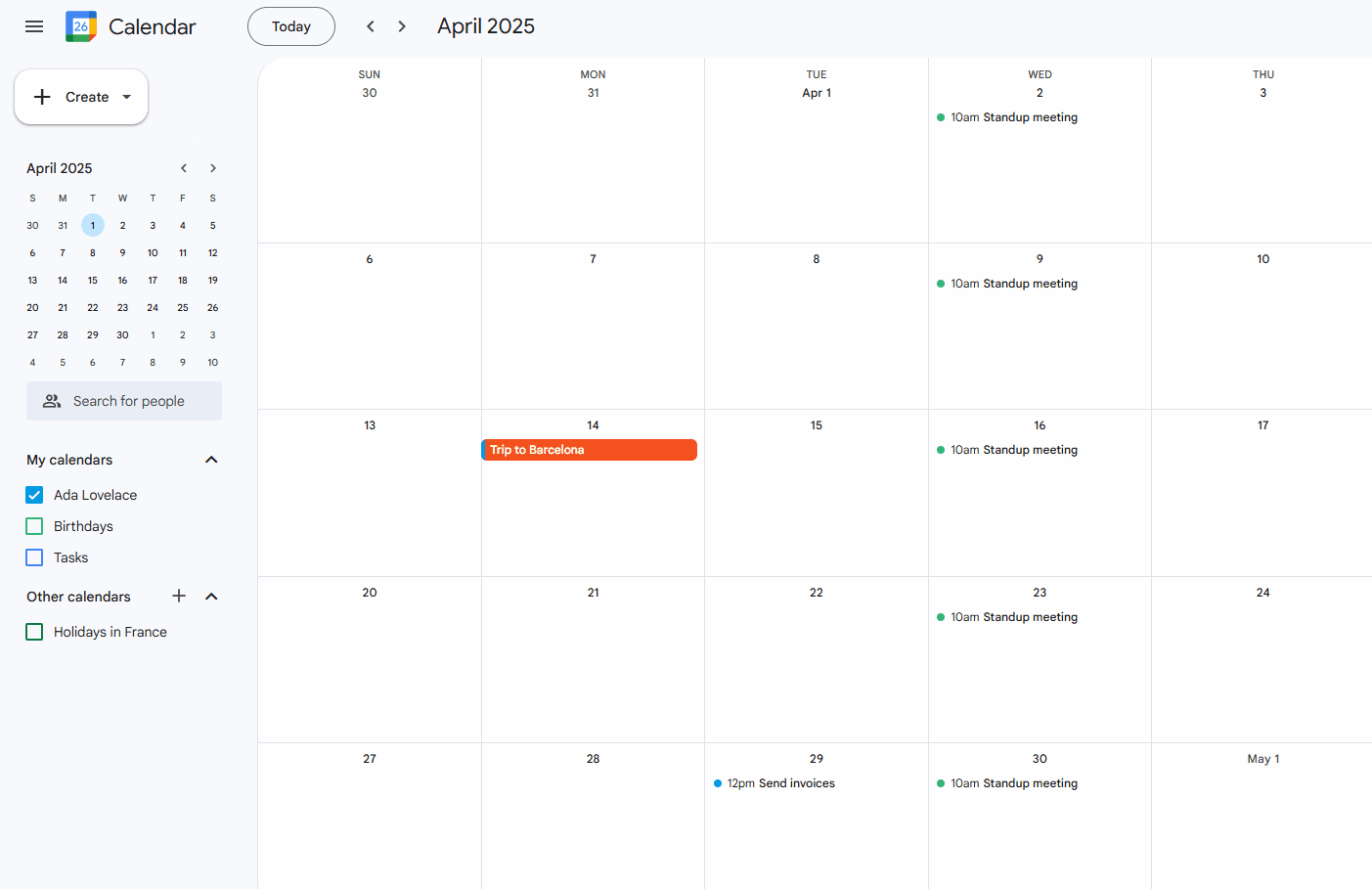Do you need to share your schedule with coworkers, family, or friends? Google Calendar makes it incredibly easy—and we’ll show you how. This quick guide walks you through the simple steps to share your entire Google Calendar, not just an event, in just a few clicks. Also, we will share with you our best tips drawn from our deep expertise in using Google Calendar.
Table of contents
Quick steps
- Open Google Calendar and pick a calendar.
- Go to Settings and sharing, then Share with.
- Enter email addresses or group IDs.
- Set the desired permission level (view only or edit).
- Click Send, then review or adjust permissions as needed.
How to share a Google Calendar with specific people
- Open Google Calendar
- Go to calendar.google.com or open the Google Calendar app on your device.
- Choose the calendar to share
- In the My calendars section on the left side (desktop) or within the sidebar menu (mobile), find the calendar you want to share.
- Access calendar settings and sharing
- On desktop: Click the three vertical dots or gear icon next to the calendar name, then select Settings and sharing.
- On mobile: Open the Settings menu, look for Calendars, and choose the calendar to share.
- Scroll to “Shared with”
- Find the heading labeled Shared with (desktop).
- Click + Add people and groups to open your sharing options.
- Enter email addresses or group IDs
- Type the Gmail addresses (or group email aliases, if you use Google Workspace) of the people you want to share with.
- Set access permissions
- Choose from the drop-down menu next to each address:
- See only free/busy (hide details): Lets them see your availability without revealing event information.
- See all event details: Allows them to view event titles, locations, and descriptions but not edit.
- Make changes to events: Gives them the ability to add, edit, or remove events.
- Make changes and manage sharing: Grants full control, including adjusting share settings.
- Choose from the drop-down menu next to each address:
- Send the invitation
- Click Send to finalize.
- Recipients will receive an email with a link to add your calendar to their own list.
- Confirm or review shared permissions
- After sharing, you’ll see who has access and what level of permission they hold.
- Return to these settings any time to modify or remove permissions.

How to share a Google Calendar with your group
A group calendar makes it simpler to coordinate events, deadlines, and meetings for a team or organization. By creating a calendar specifically for your group and granting shared access, everyone in the group sees the same schedule and can contribute to it as needed. Here’s how you can do it on Google Calendar:
- Create or identify your Google Group
- Make sure you have an existing Google Group or set one up via Google Groups.
- Verify that all intended team members are added to this group.
- Open Google Calendar and create a new calendar
- Go to calendar.google.com.
- Under Other calendars, select the plus (+) icon, then click Create new calendar.
- Give it a descriptive name (e.g., “Team Calendar”) and click Create calendar.
- Access settings and sharing
- Find your newly created calendar in the left panel. Click the three vertical dots next to it and choose Settings and sharing.
- Share with your group
- Click on + Add people and groups and enter the email address of the Google Group you want to share with.
- Select the permission level.
- Notify your team
- Click Share to finalize.
- All members of the Google Group will receive an email notifying them about the newly shared calendar.
- Manage updates and permissions
- Return to Settings and sharing anytime to add or remove group members or adjust permission levels.
- Members of the group will automatically inherit any changes, making it easy to keep your team’s access up-to-date.
How to share a Google Calendar publicly
Sharing your Google Calendar publicly allows anyone with the link or embed code to view it, making this option useful for organizations, events, or personal blogs where you want to let a broad audience know your schedule. Here’s how you can do it.
- Open Google Calendar
- Go to calendar.google.com or open the Google Calendar app.
- Select the calendar
- In My calendars, find the specific calendar you wish to share.
- Access settings and sharing
- On desktop: Click the three vertical dots or gear icon next to the calendar name, then choose Settings and sharing.
- On mobile: Open the app’s settings, locate the calendar, and tap on its sharing settings.
- Enable ‘Make available to public‘
- Under Access permissions for events, check the box labeled Make available to public.
- Confirm you understand that anyone can now see this calendar.
- Choose what details to show
- Decide whether others can see only free/busy times or full event details.
- If you select See all event details, be mindful of any private information.
- Retrieve the public link or embed code (optional)
- Below or near the Access permissions section, look for Get shareable link.
- Copy the link for direct sharing or use the HTML code to embed the calendar on a website.

⚠️ Be cautious: Publicly available calendars can reveal sensitive details if not configured properly.
What are the different Google Calendar sharing permissions?
As we’ve seen above, when sharing a Google Calendar, you can choose different permission levels for each person or group. These settings determine how much control and visibility the recipient has over your calendar. Below is a detailed overview of each permission type.
| Permission | What they see | What they can do | Use cases | Important note |
|---|---|---|---|---|
| See only free/busy (hide details) | Only free/busy times, not event titles or details | None — strictly view if you’re busy | Workplace settings or anyone who only needs to know your availability | Recipients know when you’re busy and for how long, but not specific details |
| See all event details | Full event titles, locations, descriptions, and timings | View-only | Closer collaboration: teams, family, or friends needing specific event info | They see everything but cannot edit |
| Make changes to events | Same as “See all event details” | Add, edit, and delete events | Ideal for colleagues on a shared project or assistants managing another person’s tasks | Grants significant control—only share with trusted individuals |
| Make changes and manage sharing | Same as above | Edit events and control who else has access | For co-owners, managers, or admins who oversee both the schedule and permissions | Effectively near-owner status—grant sparingly |
Additional considerations
Here are some additional considerations to help you maintain the right balance of collaboration and privacy.
- Marking events as private: Even if someone has access to “See all event details,” you can mark individual events as private. Private events show as busy blocks on your calendar without revealing information—helpful in collaborative calendars that occasionally contain personal entries.
- Revoking or adjusting permissions: You can return to the calendar’s sharing settings at any time to update, change, or remove a person’s permission level.
- Organizational settings: If you’re on a Google Workspace plan, your organization’s admin may impose restrictions on who can see or share calendars. In some cases, you can only share within your domain, or you may not have the ability to make calendars public.
💡 Recipients on iPhone or Mac? Point them to sync Google Calendar with Apple Calendar so shared events appear in Apple’s app.
Why share your Google Calendar?
Given that Gmail has over 1.8 billion active users worldwide, it’s evident that Google’s suite of tools plays a crucial role in how people communicate, organize tasks, and schedule events.
Here’s how sharing your Google Calendar can streamline collaboration, boost productivity, and ensure that everyone remains on the same page:
Team and project collaboration
If you work in a team setting, granting colleagues access to your calendar helps them see your availability for meetings, deadlines, and events.
This reduces back-and-forth scheduling discussions and fosters better time management.
👉 Learn more: 11 Best Free Project Management Software
Household and family coordination
Keeping track of kids’ activities, appointments, and errands can get complicated.
By sharing a central family calendar, each member stays informed of upcoming events and obligations.
👉 Learn more: 21 Best Organization Apps for Work and Home
Client scheduling and transparency
Freelancers, consultants, or service providers might share a calendar with clients to show real-time availability and reduce the need for numerous appointment emails.
Clients can quickly identify open slots and request meetings without guesswork.
Multi-location teams and remote work
In distributed work environments, sharing calendars simplifies scheduling across different time zones.
Coworkers can check when you’re online or offline, ensuring that meeting requests align with everyone’s working hours.
Event planning and coordination
For large events like weddings, fundraisers, or conferences, sharing a calendar with organizers, volunteers, or vendors ensures tasks and deadlines are visible to all stakeholders.
Task delegation
If you rely on administrative support or have an assistant, sharing your calendar allows them to manage scheduling on your behalf—booking meetings, adding events, and rescheduling as necessary.
Automate your calendar
How about automating your Google Calendar? Automations and integrations can transform your workflow by eliminating repetitive tasks, reducing manual input errors, and ensuring important data is always up to date.
That’s why we offer a complete synchronization service between Notion and Google Calendar for individuals and teams of all sizes: 2sync.
Notion is an all-in-one workspace that blends note-taking, database management, collaboration, and project tracking into a single flexible platform. It lets you organize just about anything in any structure that suits you best, from simple task lists to complex workflows.
To connect Google Calendar with Notion, 2sync serves as a powerful bridge that keeps both platforms in sync. With 2sync, you can:
- Map fields between Google Calendar and Notion databases so events and entries remain accurate in both places.
- Filter data to include only items that are truly relevant to you or your team.
- Customize sync modes (one-way or two-way) based on your unique workflow requirements.
By automating your schedule and centralizing your tasks, 2sync frees you from constant app-switching.
🚀 Try your first automation today!
FAQ
If you share your calendar publicly with a link, people can view it without a Google account. However, to edit or add events, users generally need a Google account and the correct permission level (e.g., “Make changes to events”).
Mark private events as “Private,” so anyone who has permission to view your calendar only sees “busy” blocks instead of event titles and details.
Ask them to check their spam folder, verify you used the correct address, and resend the invite. You can also share the public link or calendar ID directly.
Go to “Settings and sharing” for that calendar. Under “Share with specific people,” locate the person or group. Use the drop-down to change permission levels or remove access entirely.
In “Settings and sharing,” scroll to “Integrate calendar.” You’ll see the iCal URL (ending in .ics). Copy this link and paste it into external calendar apps such as Apple Calendar or Outlook.
Yes. In Google Calendar’s settings, look for “Trash.” Deleted events are stored there for a certain period, allowing you to recover them if needed.
Your organization’s admin may restrict calendar sharing options. Some domains only allow internal sharing or disallow public calendar sharing entirely for security or privacy reasons.
Absolutely. You can create multiple calendars for different purposes (e.g., personal, work, or projects). Assign distinct names and colors to keep them organized and easily identifiable.
Yes, you can share individual events by adding guests to the event. Open the event in your calendar, click on “Add guests,” enter their email addresses, and send the invitation. This grants access to that specific event without sharing your entire calendar.
Google Calendar does not provide a feature to track who has viewed your calendar. You can see who has access in the sharing settings but not their viewing activity.



